
Section E New Testament
Chapter 47 - Southern Wall Double Gate, Triple Gate, Stair Steps, Single Gate, Burnt Shops
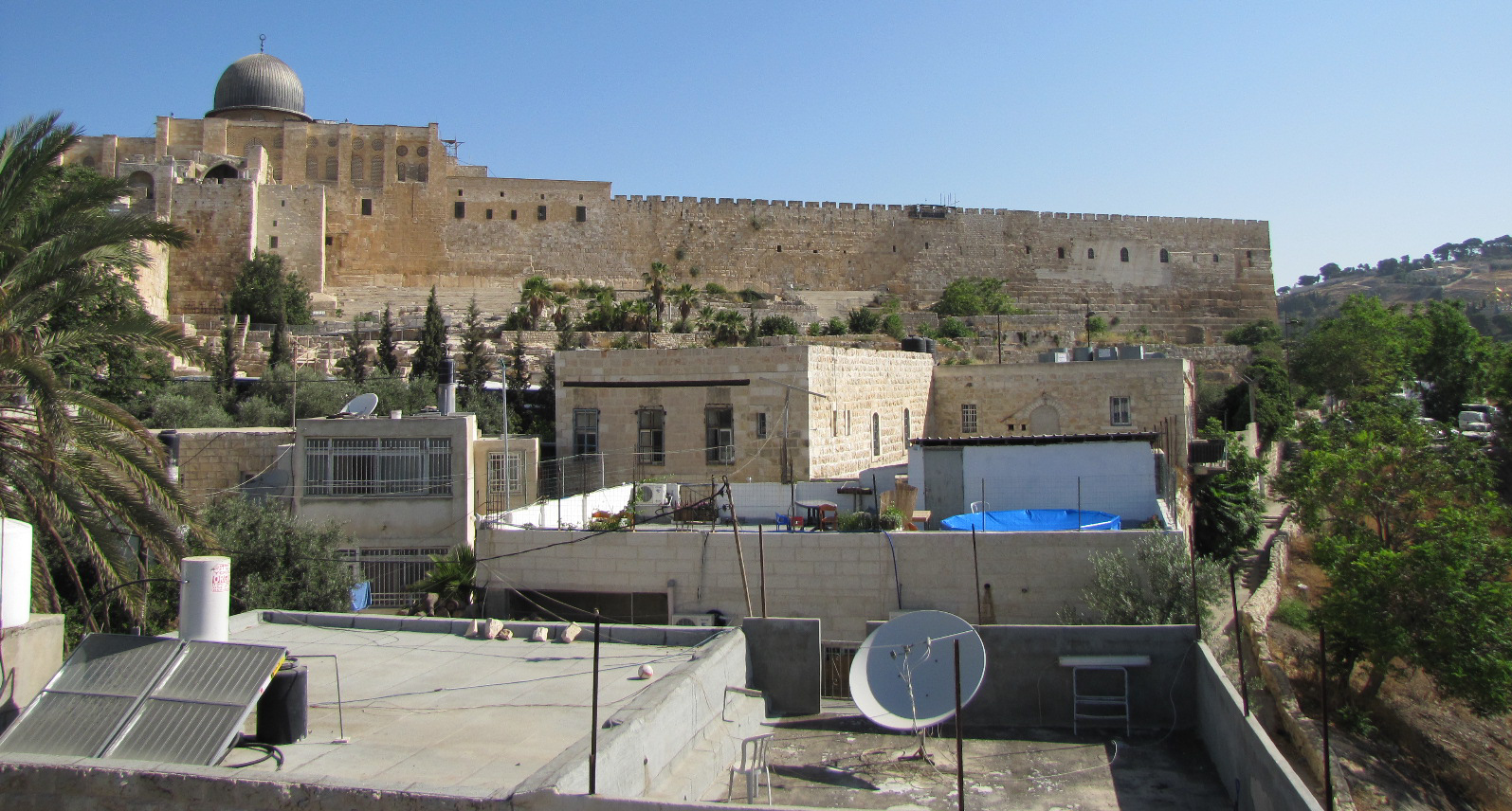
This is a view of the eastern two-thirds of the southern wall. Notice the how quickly the ground level drops off as the wall continues toward the east (right). The dome of the Al Aqsa Mosque can be seen where Solomon’s Porch, or the Royal Stoa, of the Jews once stood on the south side of the Temple Mount.
A 22-foot wide street also ran along the southern wall of the Temple. About 37 feet of this street can still be seen at the southwest corner, where it begins to ascend rapidly through a series of stairs until it reaches the Double Gate. Although we know the route, the street is not visible after the initial 37-foot section until it reaches the Double Gate. At the Double Gate it is again visible down to the Triple Gate.
Stairs run up to this street from the south, coming up the Ophel from the south. The remains of these stairs are also still visible. In fact, they are still useful to visitors. As the street continues along the southern wall toward the east a series of vaults, similar to the vaults under the street along the Western Wall, were built to support it. These vaults, or arches, supported the street along the southern wall and were also used as shops.
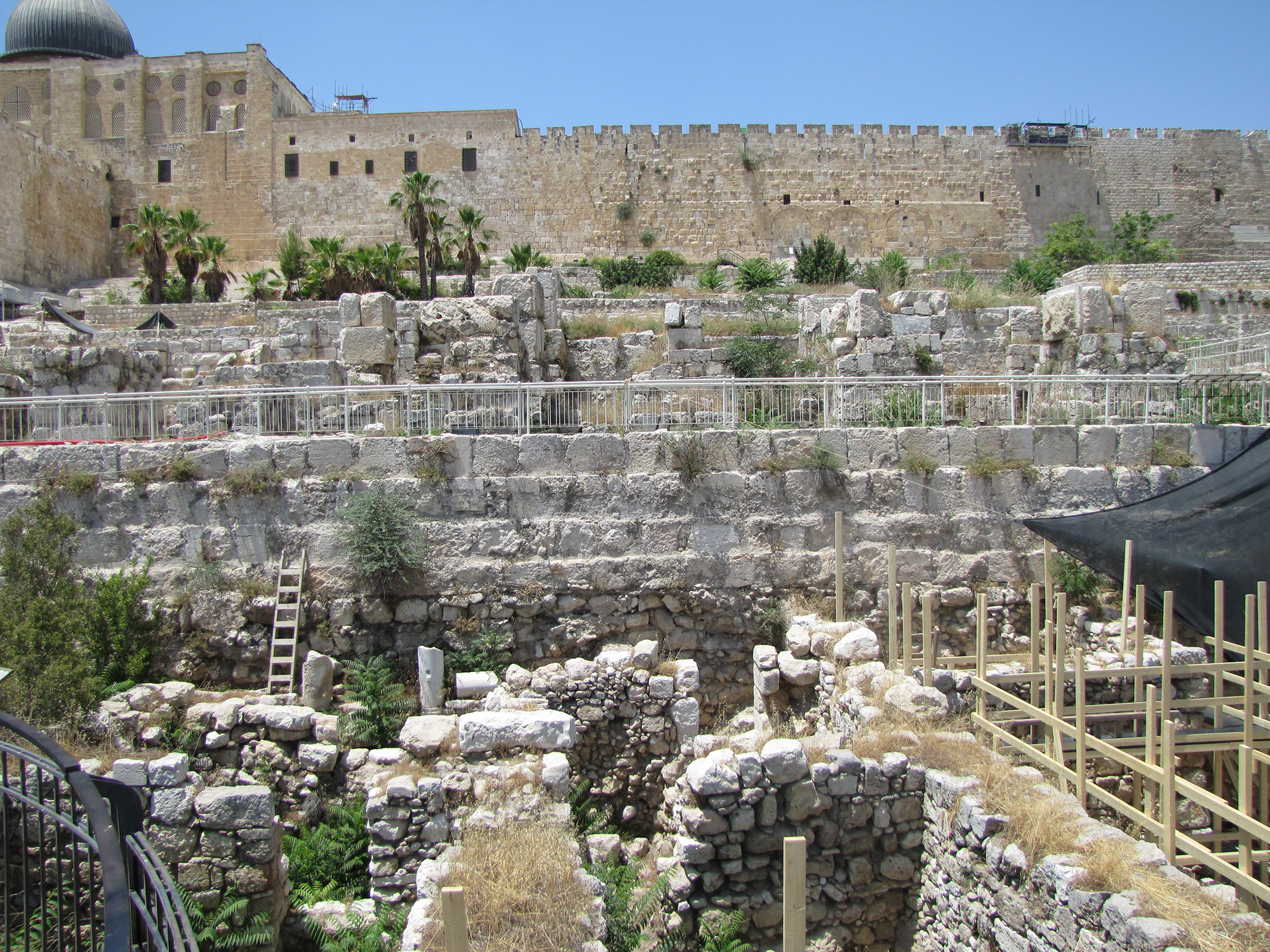
Since 1967 when the Israelis took control of eastern Jerusalem, extensive excavation has been done in this area called the Ophel south of the Temple Mount.
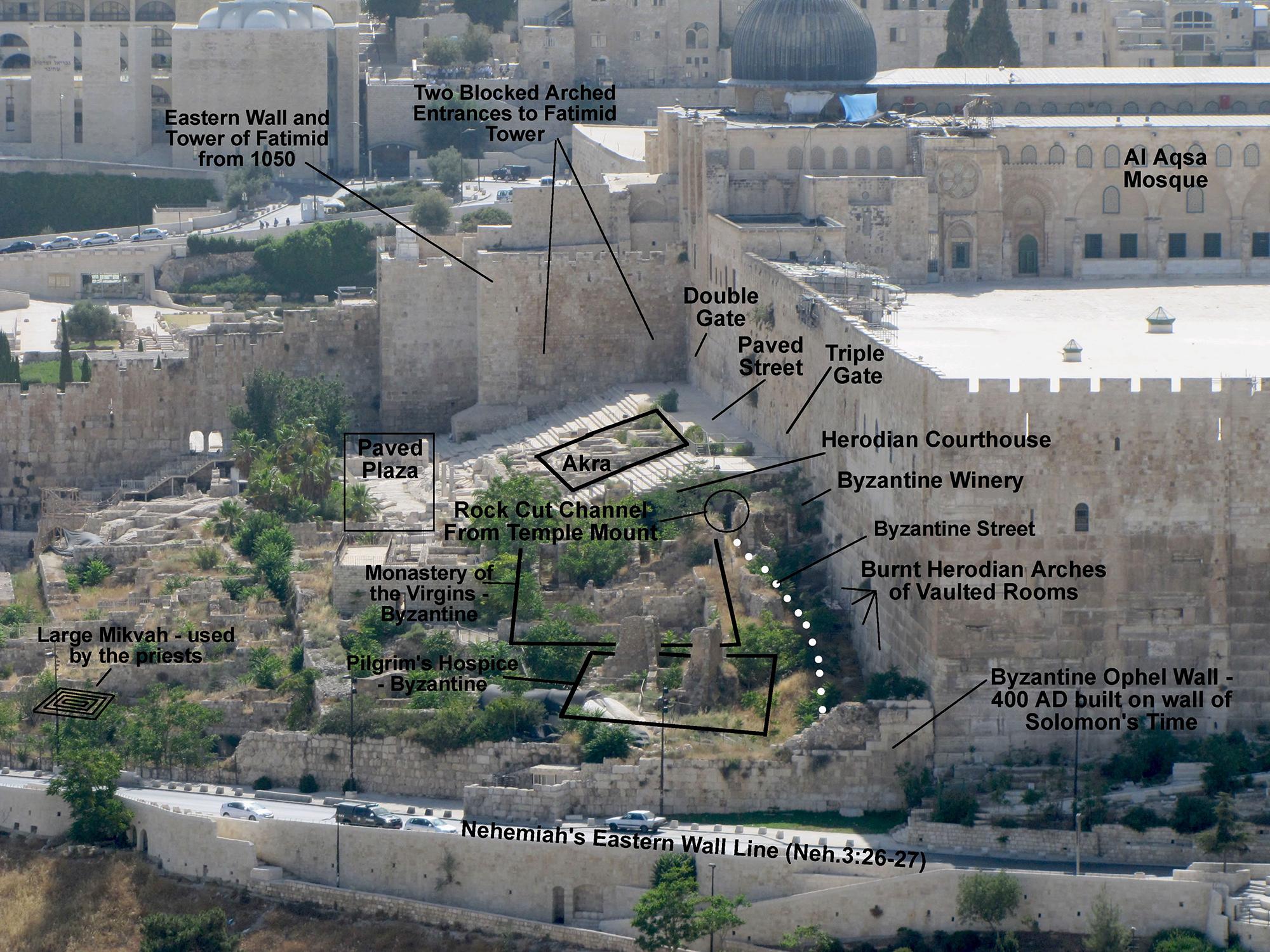
A view of the southern wall and the excavation done in the Ophel area. Notice the location of these things:
1) paved street, 2) the Double Gate, 3) the Triple Gate, 4) marks from the Burnt Herodian Arches, and 5) the two large sets of stairs (not labeled) leading up to the Double and Triple Gates. It may also be of interest to recognize where the remains of the Akra, the old Seleucid fortress, is.
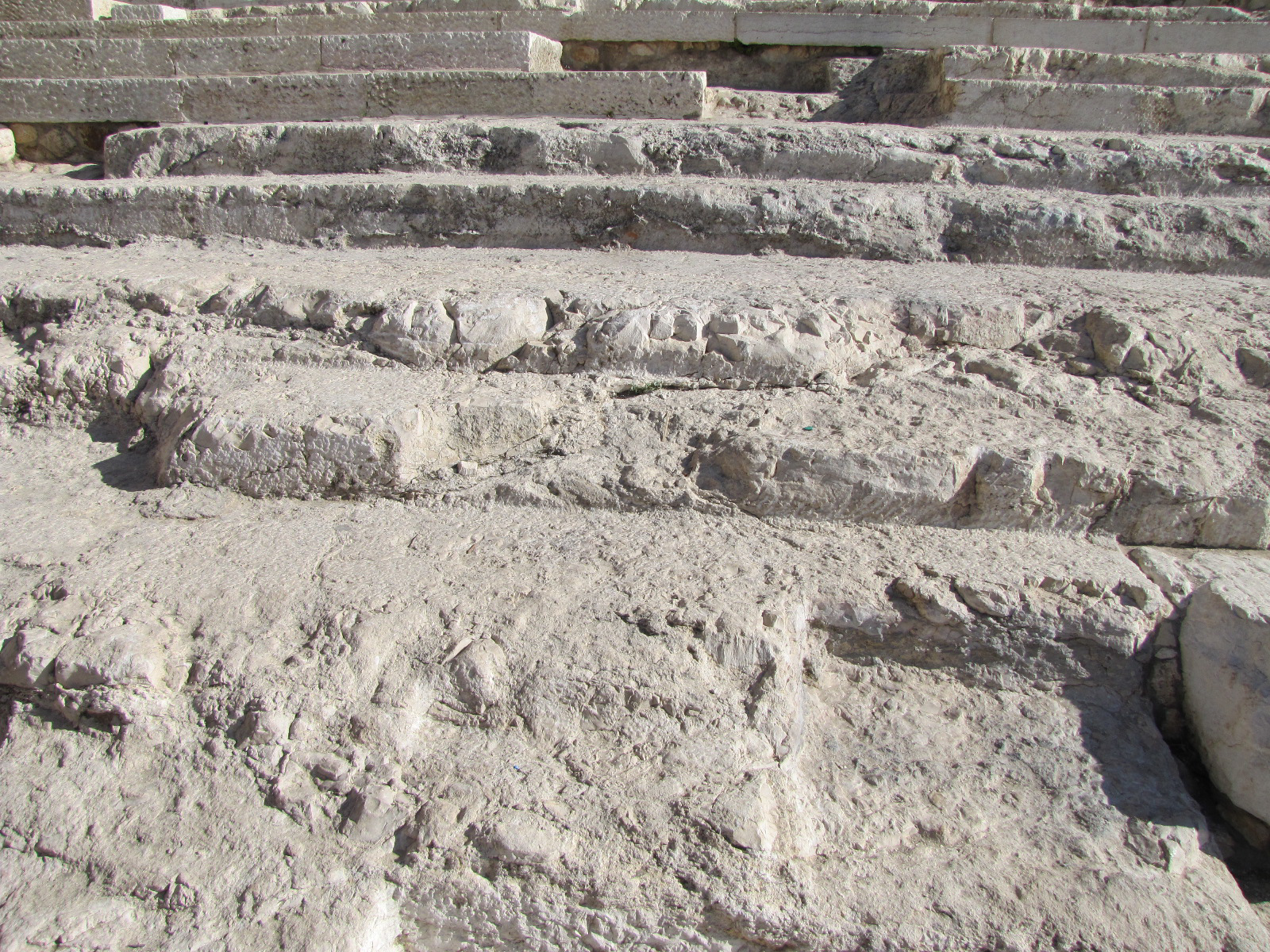
The worn steps cut into the bedrock of Mount Moriah as it ascends to the Temple Mount in front of the Double Gate in the Ophel.
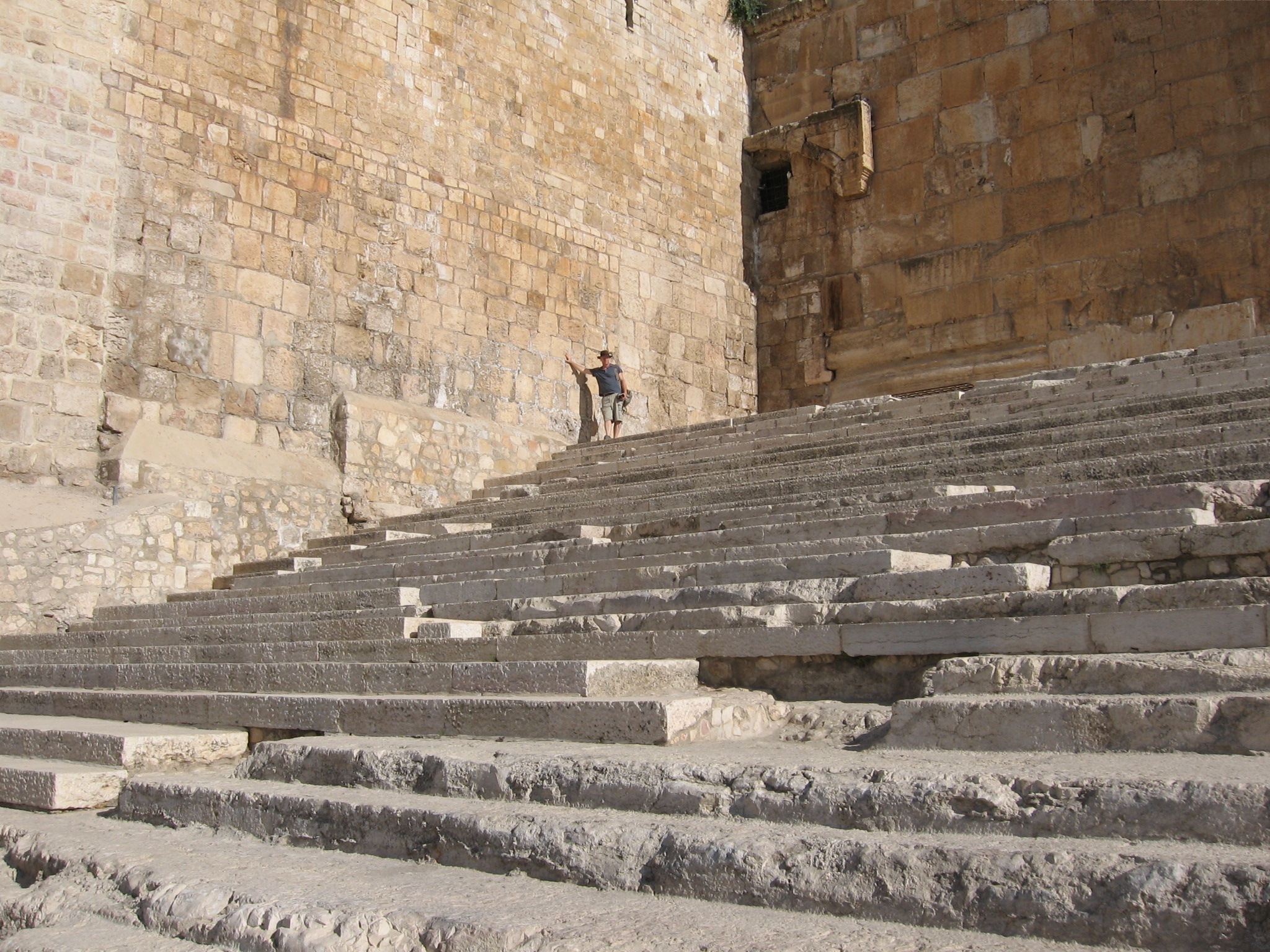
This flight of stairs is 210 feet wide. The stairs are a combination of smooth stone slabs and carved bedrock. The stairs alternate between a 35 inch run (the length of the step) and a 12 inch run, except for the first and last three steps, which are all 12 inches. The alternating step width caused the Jewish worshippers to proceed toward the Temple Mount with a steady, unrushed pace. Jewish writings record Gamaliel (the Apostle Paul’s Jewish instructor and the man who suggested the release of the Apostles in Acts 5:34) sitting on these steps with the elders:
It happened once with Rabban Gamaliel and the elders, that they were sitting on the stairs in the Temple Mount. -Tosefta Sanhedrin 2:6
In this photo, Galyn leans against a tower of the Knights Templar that was built right up against the Double Gate by the Crusaders to protect the city from Muslim invaders. A lintel from the Umayyad Period (661-750 AD) can be seen over the Double Gate. Part of the lintel was covered up by the Knights Templar when they built their fortification in about 1129 AD.
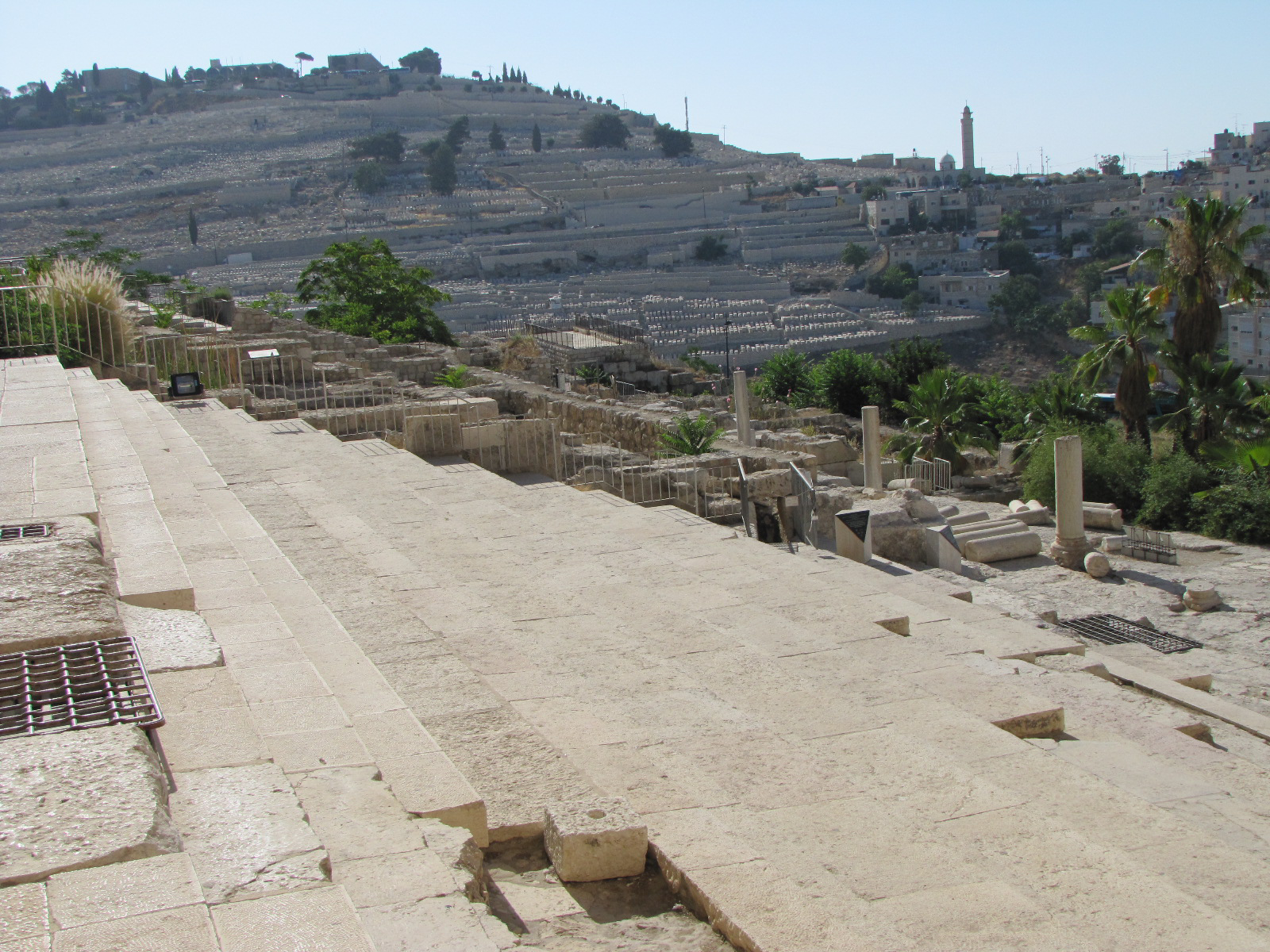
A view looking east-southeast down the steps over the Kidron Valley toward the southern summit of the Mount of Olives. At the foot of these stairs are numerous mikvah (ritual baths) used by the Jews for purification. These mikvah were likely used by the Apostles on the Day of Pentecost in Acts 2 for baptizing the 3,000 new Jewish believers in the name of Jesus. On that day, these steps would have been crowded - first, because it was the Jewish feast of Pentecost, and second, because of the events recorded in Acts chapter 2.
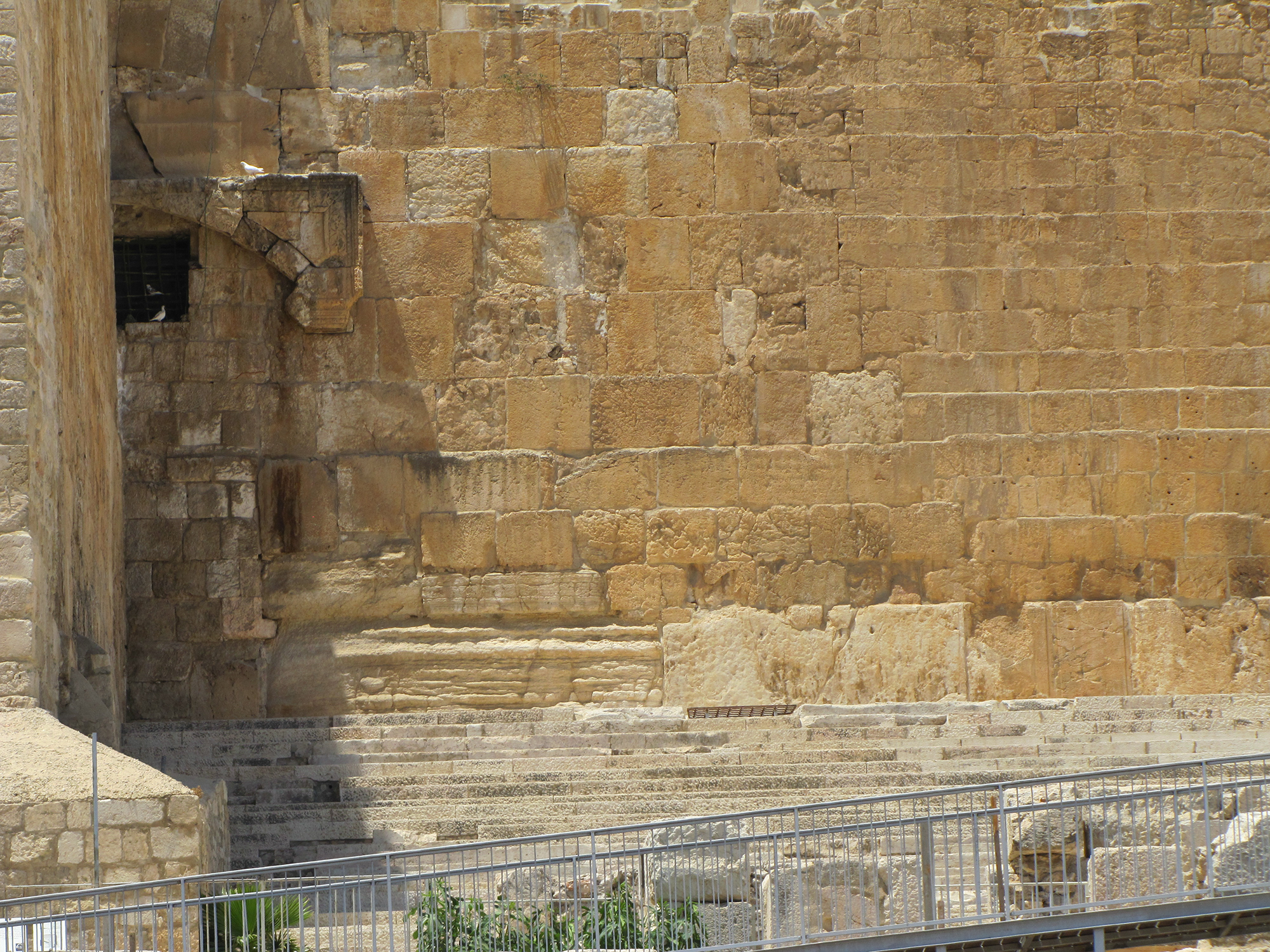
A view of the eastern half of the Double Gate. This gate led into a magnificently decorated tunnel under the Temple Mount's Royal Stoa (Solomon’s Porch) which led to a set of stairs that brought the worshipper up to the surface of the Temple Mount. The distance from the street level in front of the Double Gate up the stairs to the Temple Mount surface is about 46 feet.
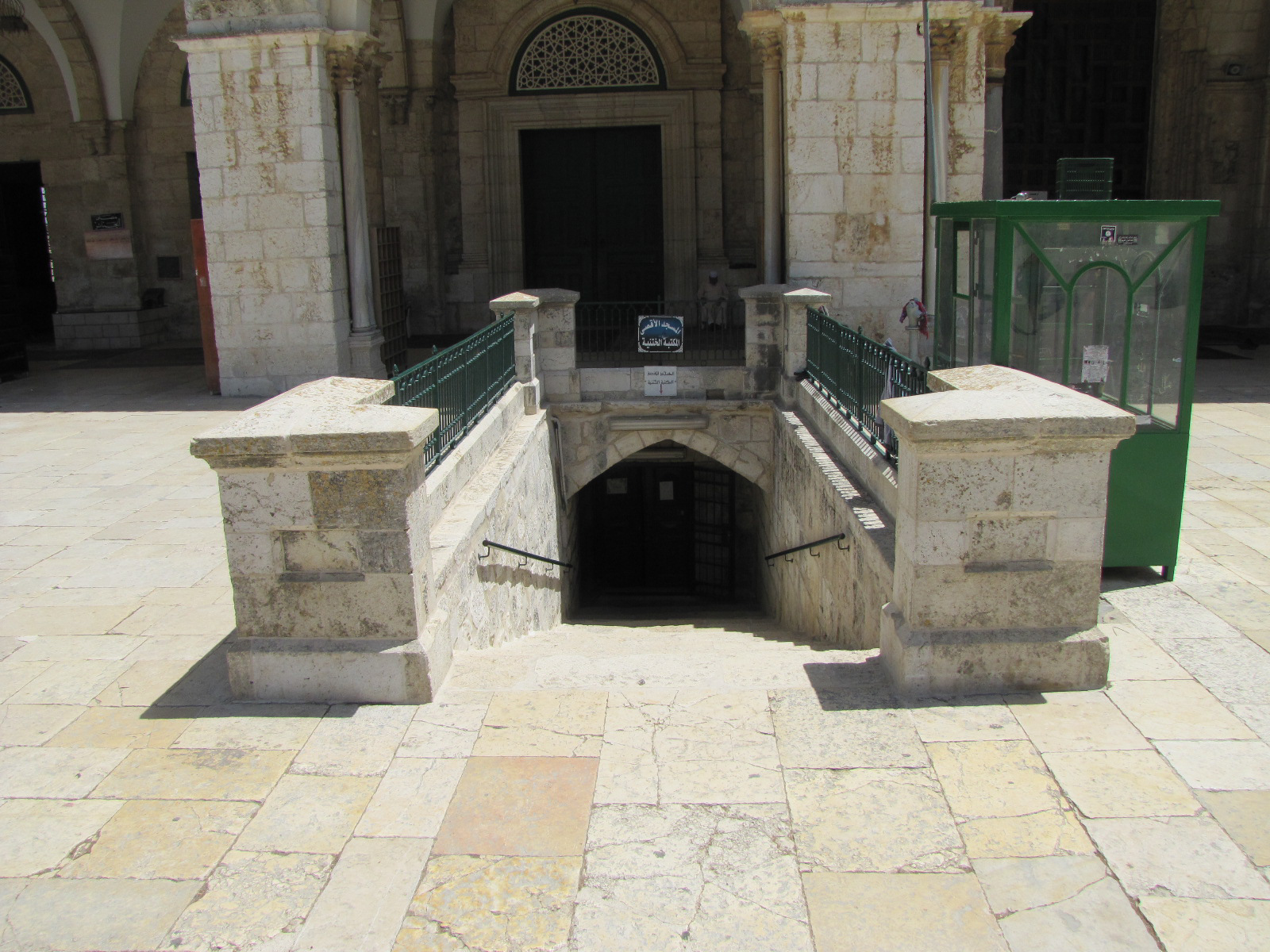
This is a photo from the Temple Mount where the worshipper would emerge after entering the Double Gate. Today this entrance is only accessible to Muslims (although, I have to admit that I was tempted run down the stairs into the tunnel to see and photograph the decorations in the rock walls and domed ceilings). The building behind this is the Al Aqsa Mosque which is considered the third most holy site in the world for Muslims after Mecca and Medina.
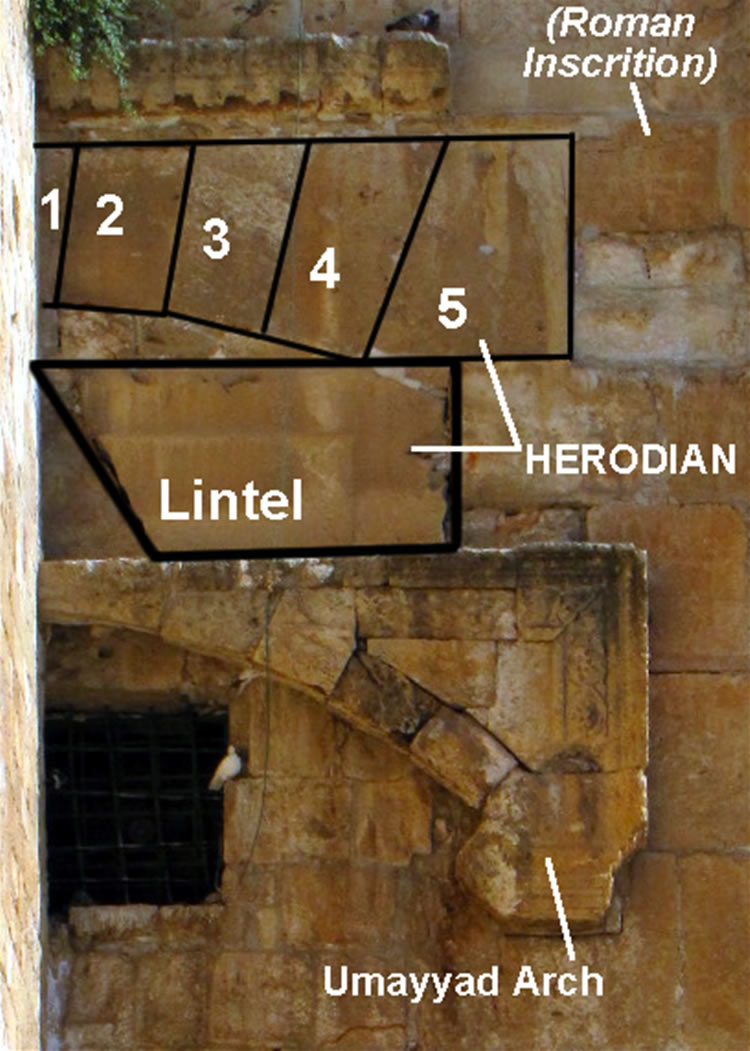
Above the Umayyad Arch (built in the 600's AD by the Muslims) are four trapezoidal stones which form the arch of Herod's New Testament Temple Mount entrance. Below the trapezoidal stones is a large horizontal stone with a wide margin and boss carved into it. This is the lintel for the Herodian Double Gate. To the left behind the Crusader wall, the rest of the gate can be seen.
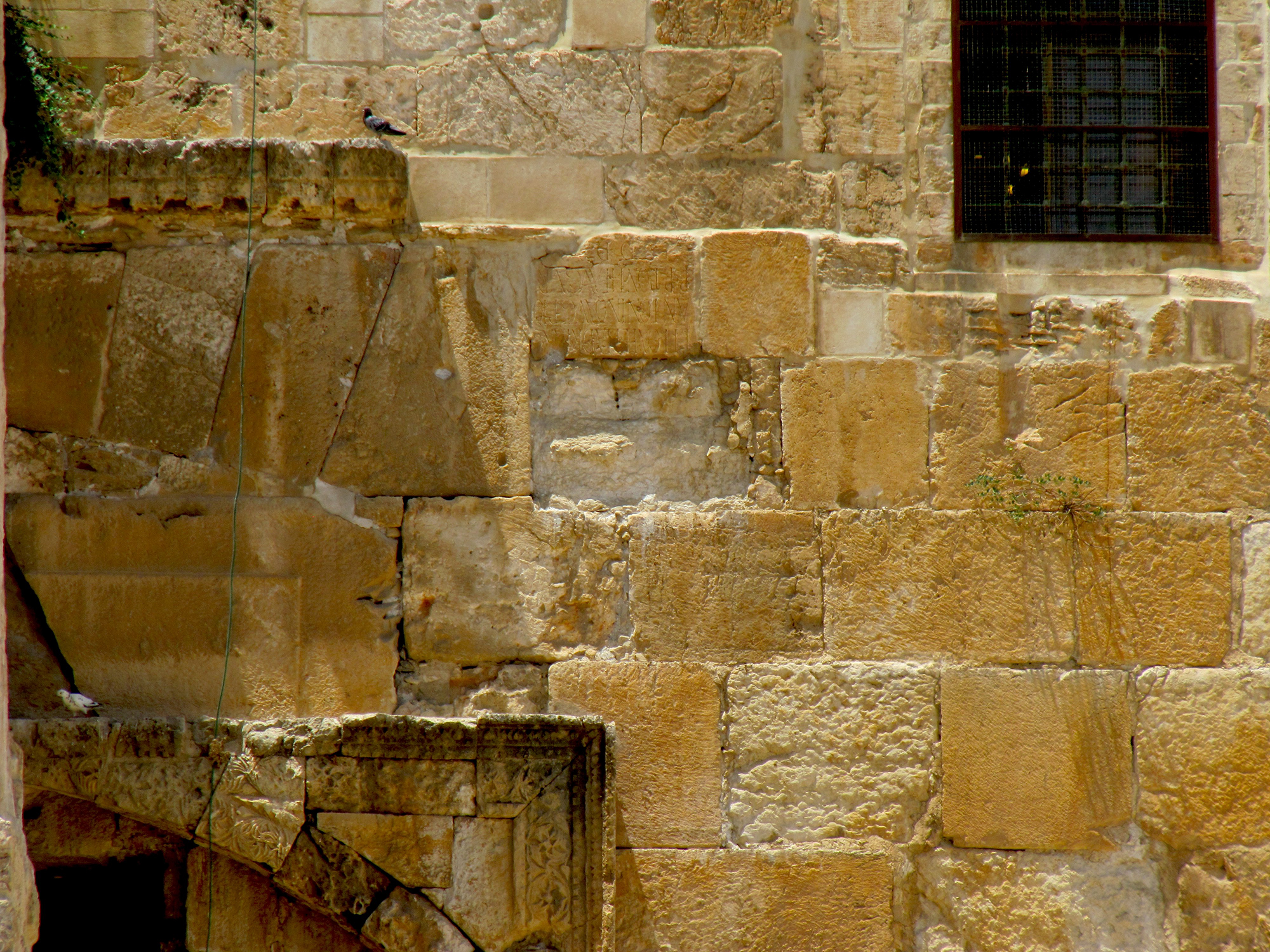
Notice the four trapezoidal stones forming the arch of the Double Gate from the days of Herod, and the large horizontal lintel directly below them with the wide margin and boss. The decorative arch attached to the face of the wall is from the late 600’s AD. Also notice the square stone that sets immediately to the right (east) of the fourth trapezoidal stone, even with the top of the arch. This stone is etched with a Roman inscription and was placed in the wall upside down. It is the base of a Roman statue that sat on the Temple Mount in the days of Hadrian after the second Jewish revolt was quenched in 135 AD.
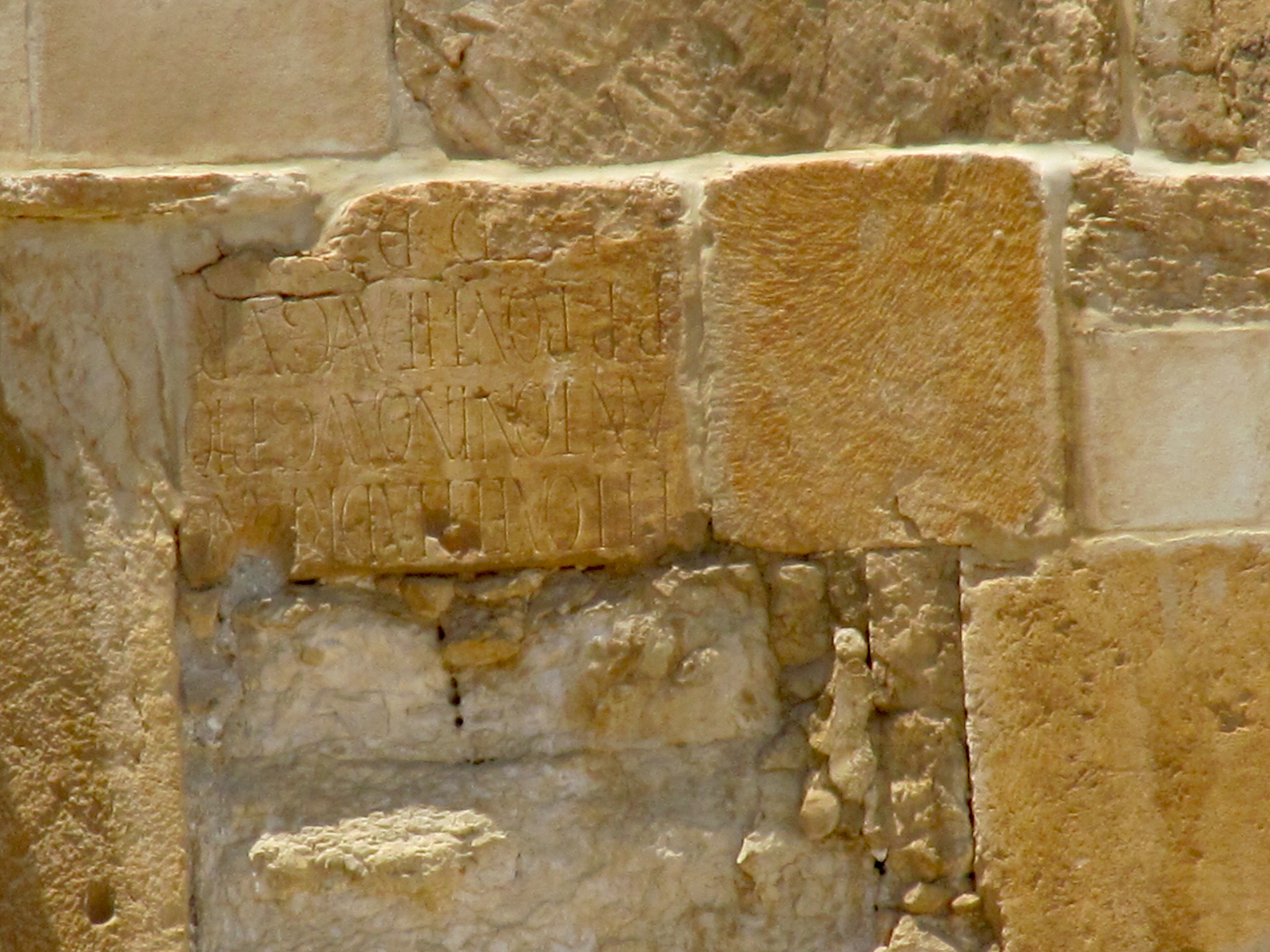
The upside down inscription is from the Roman statue of Emperor Antoninus Pius (138-161 AD) that the Bordeaux Pilgrim recorded seeing when he was on the Temple Mount in 333 AD. The statue was destroyed by the Byzantine Christians after 333 AD, the Jews in 614 AD or the Muslims in 638 AD. This reused block is the only part found so far of the two statues (one of Hadrian, and this one of Antoninus Pius.)
Shown rightside-up, the inscription reads:
To Titus Aelius Hadrianus
Antoninus Augustus Pius
The father of the fatherland, pontifex, augur
Decreed by the Decurions
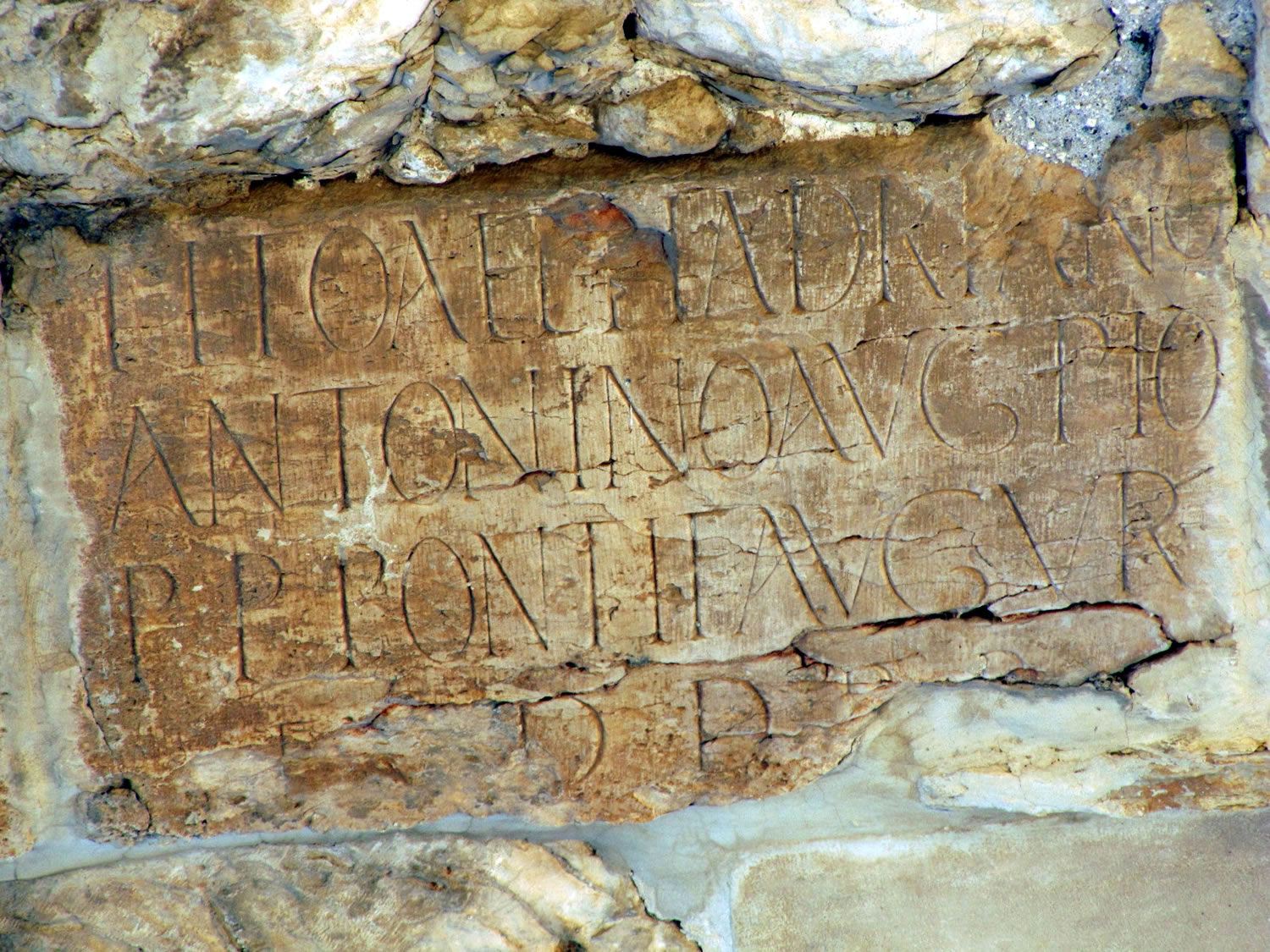
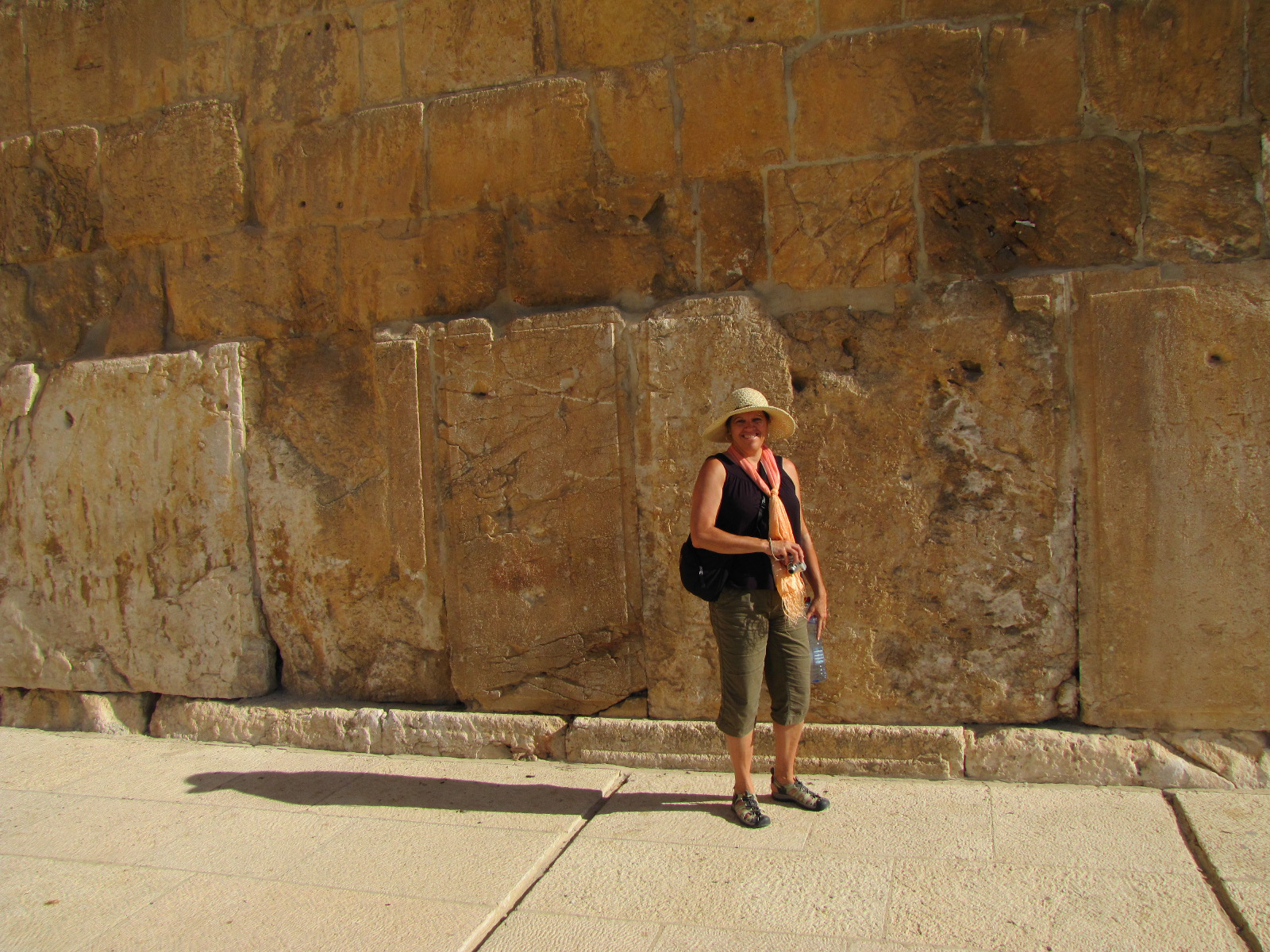
Toni stands on the street pavement along the southern Temple Mount wall between the Double and Triple Gates at the top of the large staircases. The large six-foot-tall ashlars behind her are original Herodian stones remaining from the Temple Mount that was destroyed in 70 AD. This course of ashlars is double the height of the average ashlar because they served as the “master course.” Notice that at the street level, the margin and bosses of a lower course of ashlars can be seen directly behind Toni’s feet.
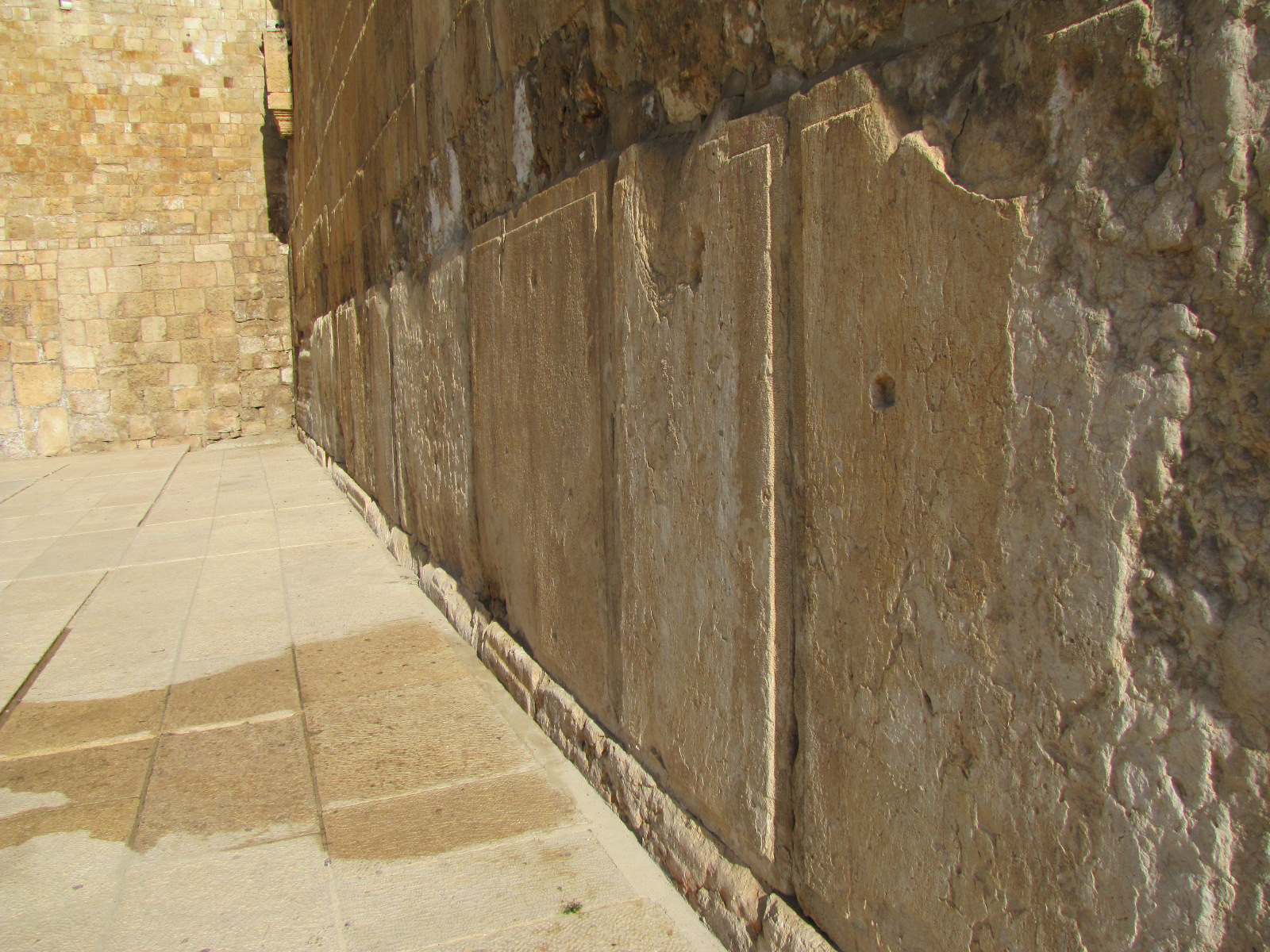
This photo is looking west toward the Double Gate and the wall of the tower of the Knights Templar. The Triple Gate was directly behind me when the photo was taken. The Double Gate and Triple Gate are 230 feet apart. The course of six-foot ashlars from the New Testament days can be seen in this course which is just left of the Triple Gate and continues to the Double Gate. The stones above this course are the work of Romans, Jews or Muslims (no one knows for sure) who rebuilt the southern wall of the Temple Mount.
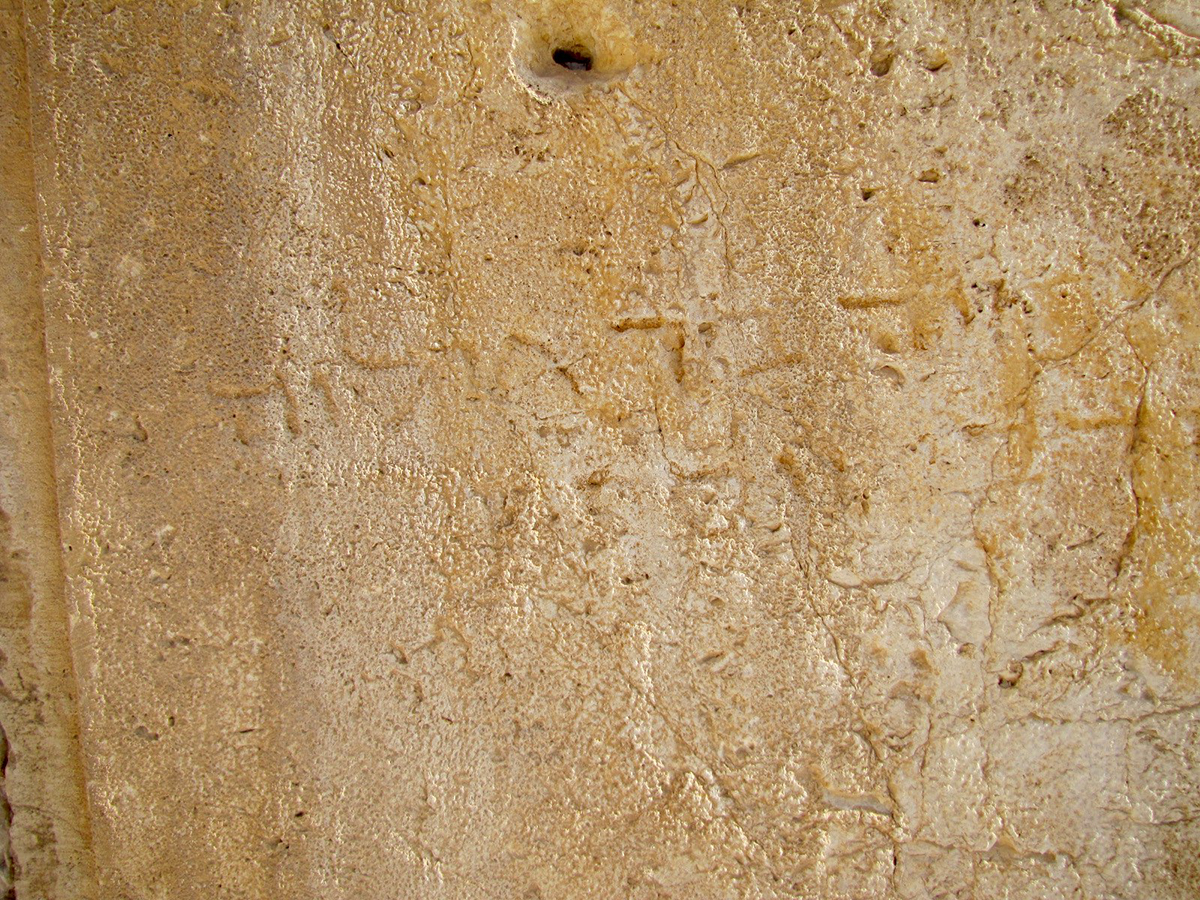
A Hebrew inscription of the name Berachia Bar Gedalya Bayrav in one of the large six-foot ashlars located between the Double and Triple Gates can be seen. All we know for sure is the name that is inscribed. The details of who, when and why are unknown.
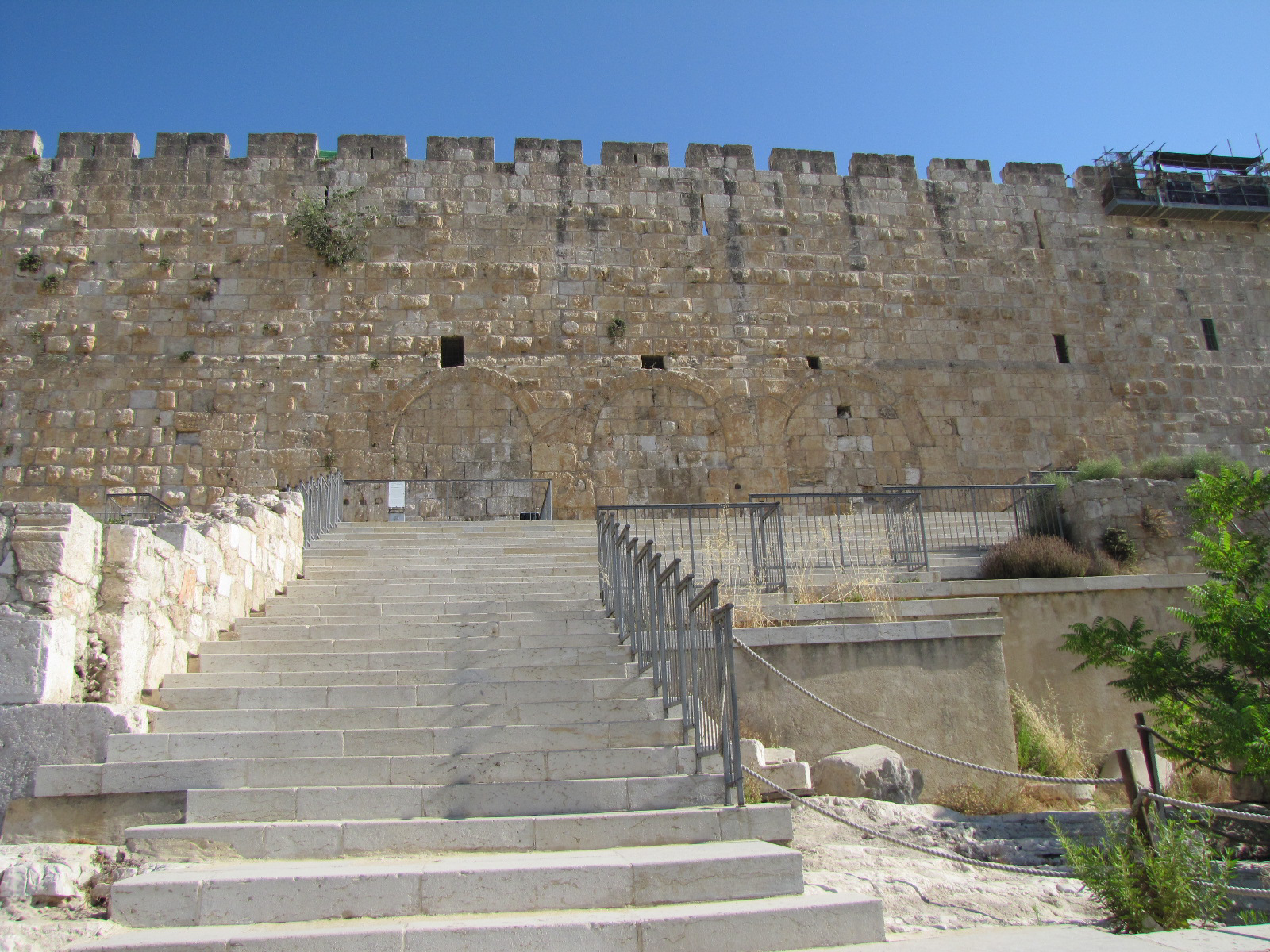
The Triple Gate can be seen at the top of these rebuilt stairs. The Triple Gate is 230 feet east of the Double Gate and is 51 feet wide. Each of the three gates is 13 feet wide with two 6 foot piers separating them.
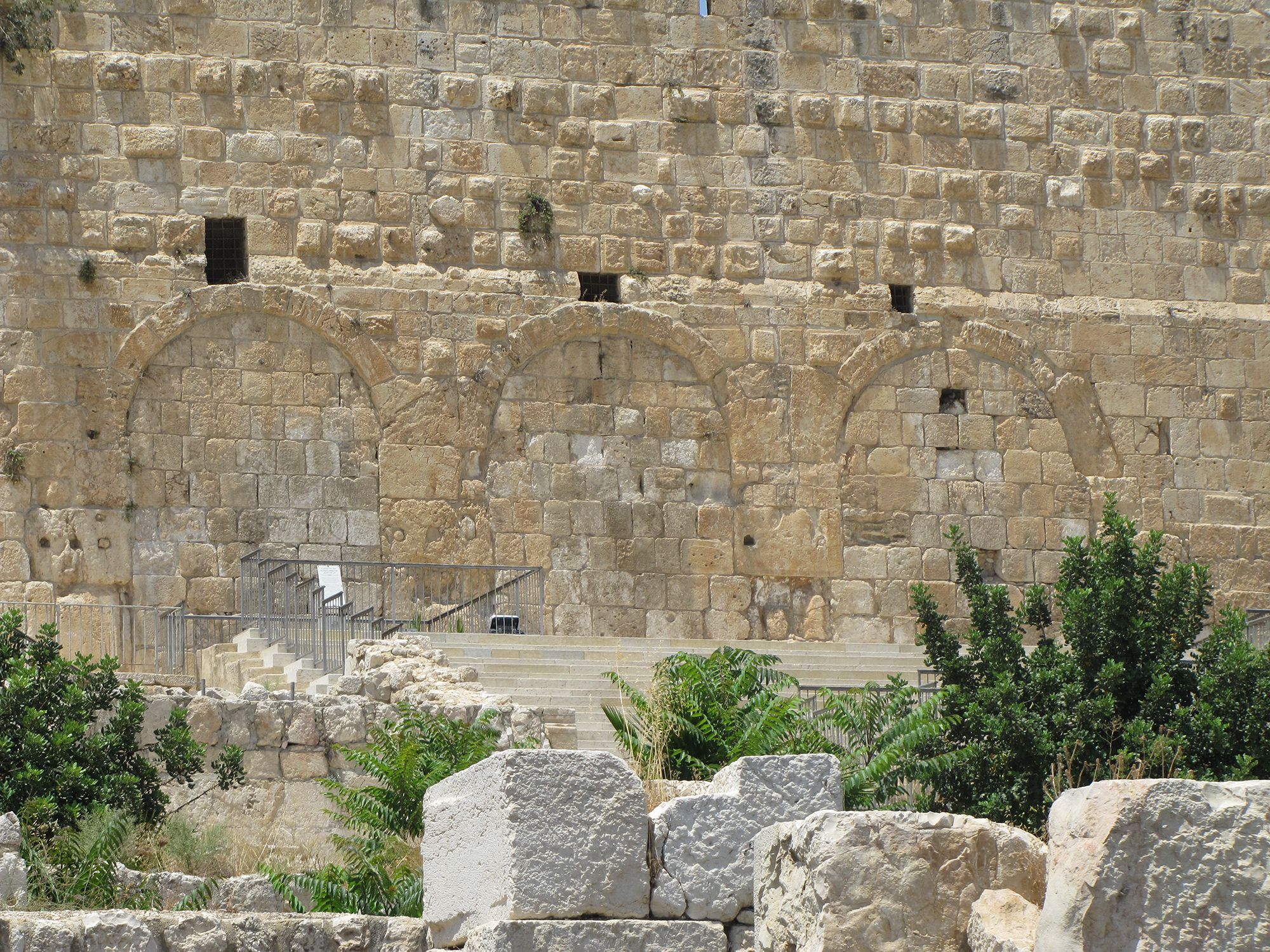
The Triple Gate led visitors under the Temple Mount through a decorated tunnel beneath the Royal Stoa on the south end of Solomon’s Colonnade, then to a stairway which took worshippers up to the outer courtyard of the Temple Mount. This Triple Gate is likely the “Beautiful Gate” of Acts 3:2: One day Peter and John were going up to the temple at the time of prayer – at three in the afternoon. Now a man crippled from birth was being carried to the temple gate called Beautiful, where he was put every day to beg from those going into the temple courts. When he saw Peter and John about to enter, he asked them for money . . . Then he went with them into the temple courts, walking and jumping, and praising God. When all the people saw him walking and praising God, they recognized him as the same man who used to sit begging at the temple gate called Beautiful . . . While the beggar held on to Peter and John, all the people were astonished and came running to them in the place called Solomon’s Colonnade. - Acts 3:1-11
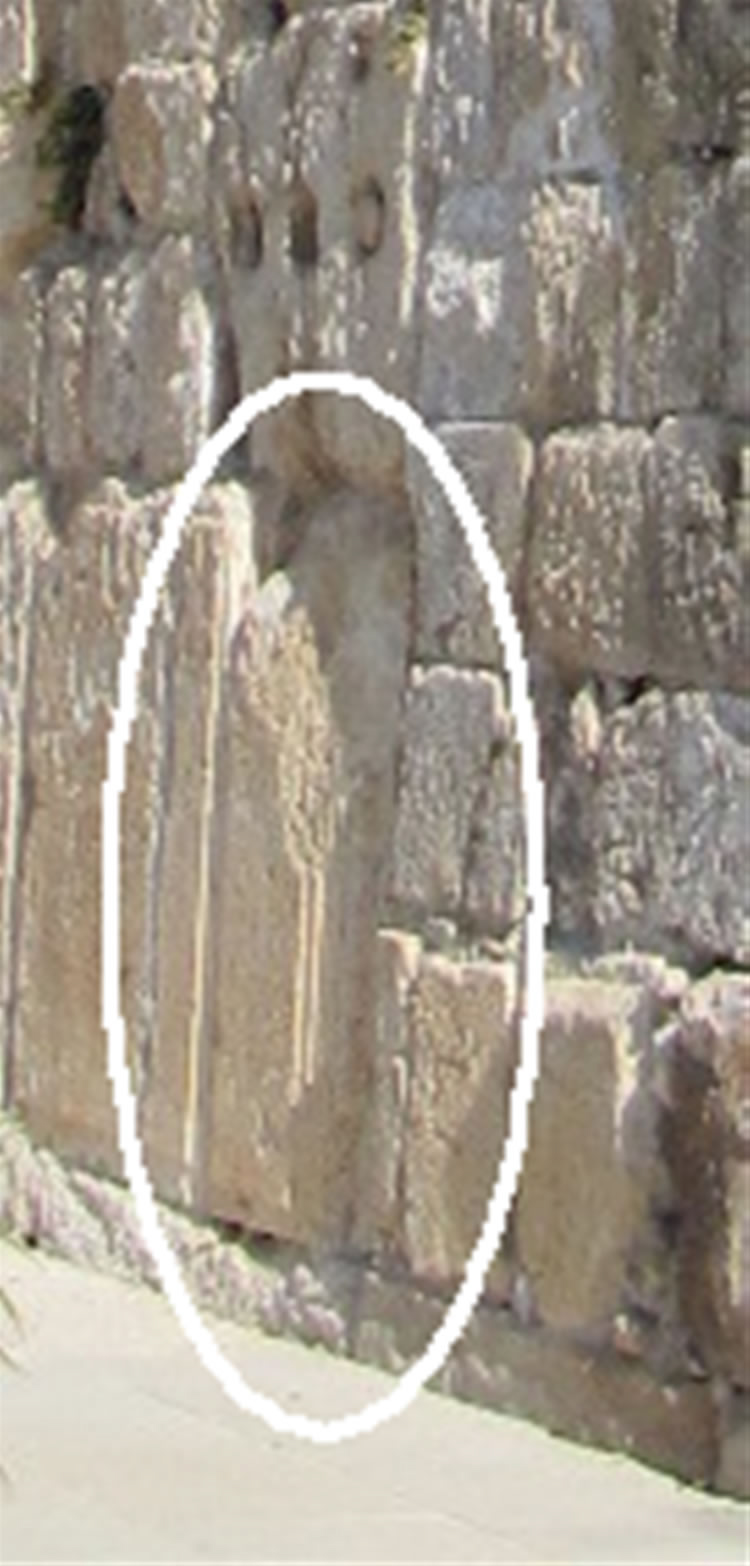
To the left (west) side of the first gate of the three, decorative rock carvings in the door jamb can still be seen on the ashlar stone that was part of the Triple Gate or Beautiful Gate. The highly decorated stones may be the reason it was called “The Beautiful Gate.” Jesus and the apostles would have surely walked through this gate that led up to the outer courts and Solomon’s Porch, where the early church in Jerusalem met daily.
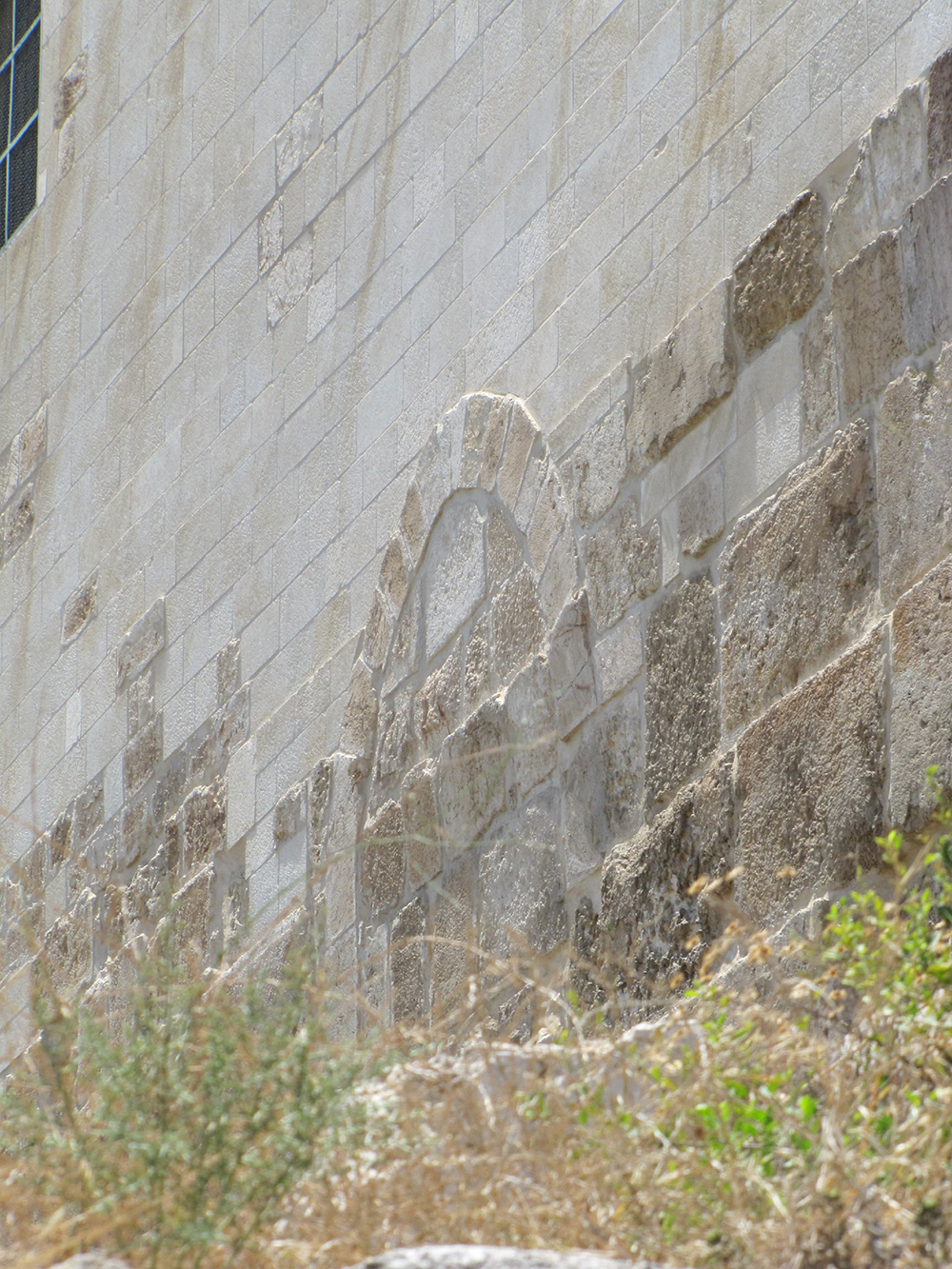
Further to the east on the south wall is the Single Gate. It was cut by the Knights Templar and is not original to the Temple Mount. The Crusaders used this gate to access the caverns below the Temple Mount, where they kept their horses. The caverns are called “Solomon’s Stables.” The gate was blocked shut by Saladin in 1187 when the Muslims returned. Below this arch are the remains of other arches that supported the Herodian street that ran the full length of the southern wall. The vaulted rooms created by this arched support system were used as shops. The intense heat from the Roman fire in 70 AD seared the wall below the Single Gate, and created burnt impressions of the arches. Theimpressions burnt onto the Herodian ashlars still clearly show where these shops and their vaulted walls stood.
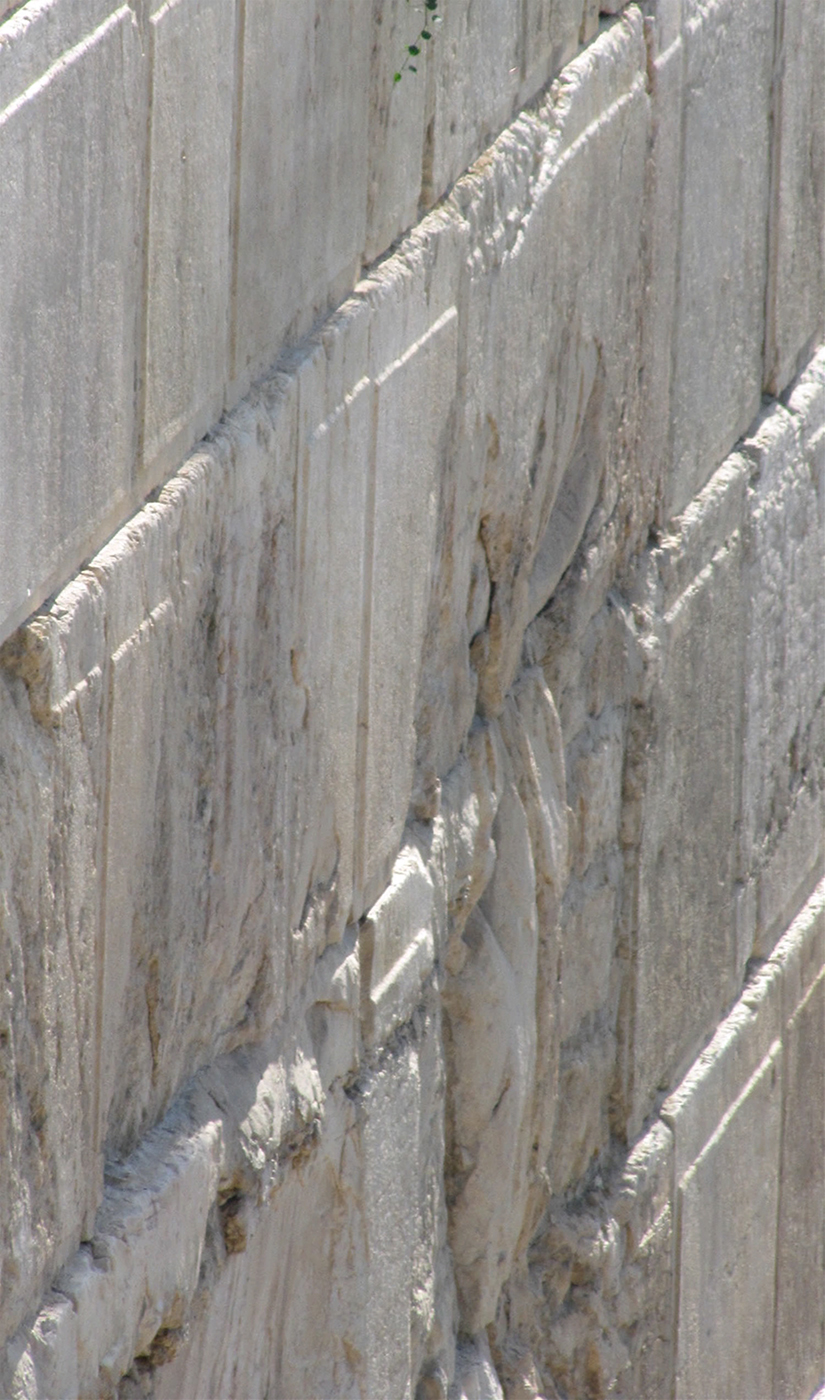
A close up of a burnt impression.
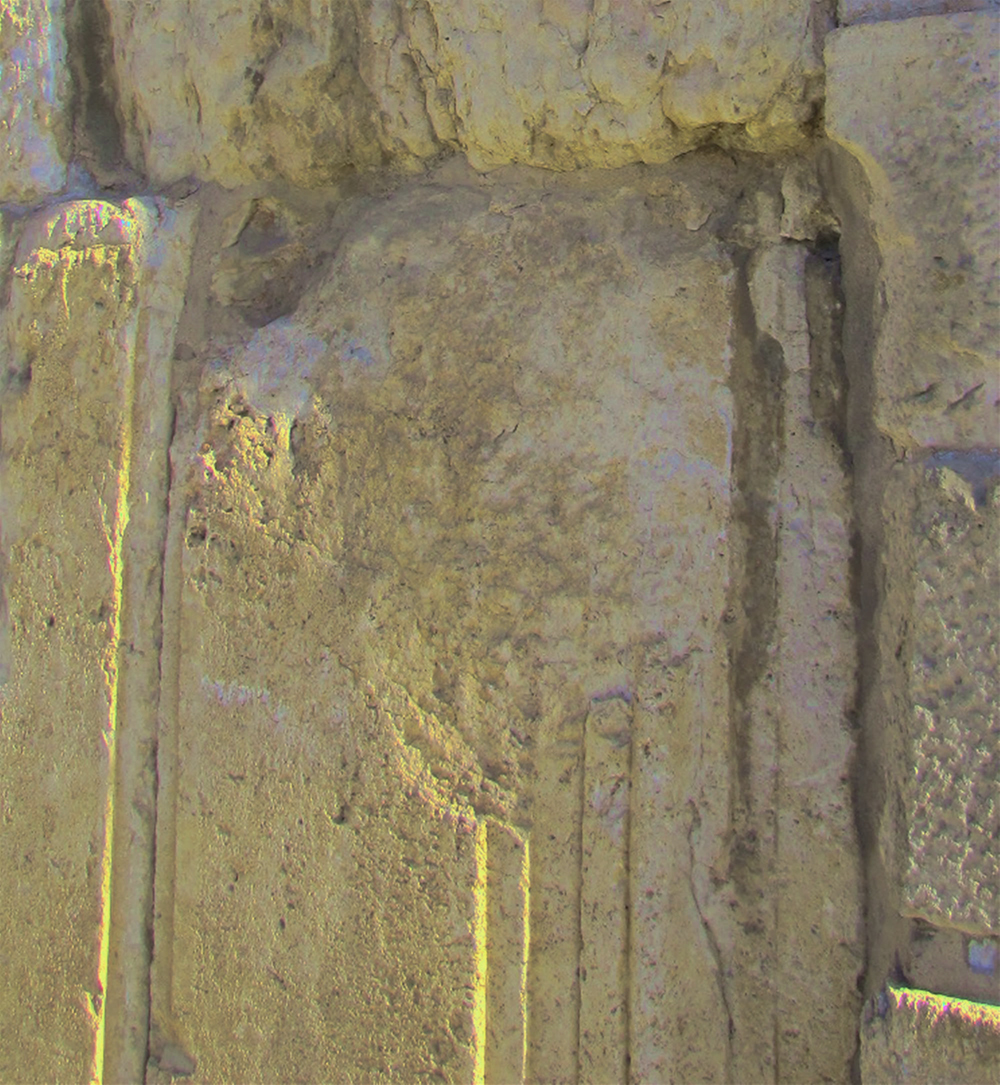
A close up of the stone carvings from the west door jamb of the Triple Gate. This is all that remains of Herod's original gate, called the Beautiful Gate, that served as an entrance to the tunnel and staircase that still exist behind this blocked gate. This ashlar is 48 inches long. Eighteen inches are decorated with a classical gate profile, and the remaining 30 inches are carved in a style typical of Herodian ashlars. The Triple Gate was rebuilt during the Umayyad Dynasty (661-750). The Crusaders blocked it shut to protect themselves from the Muslims around 1100.
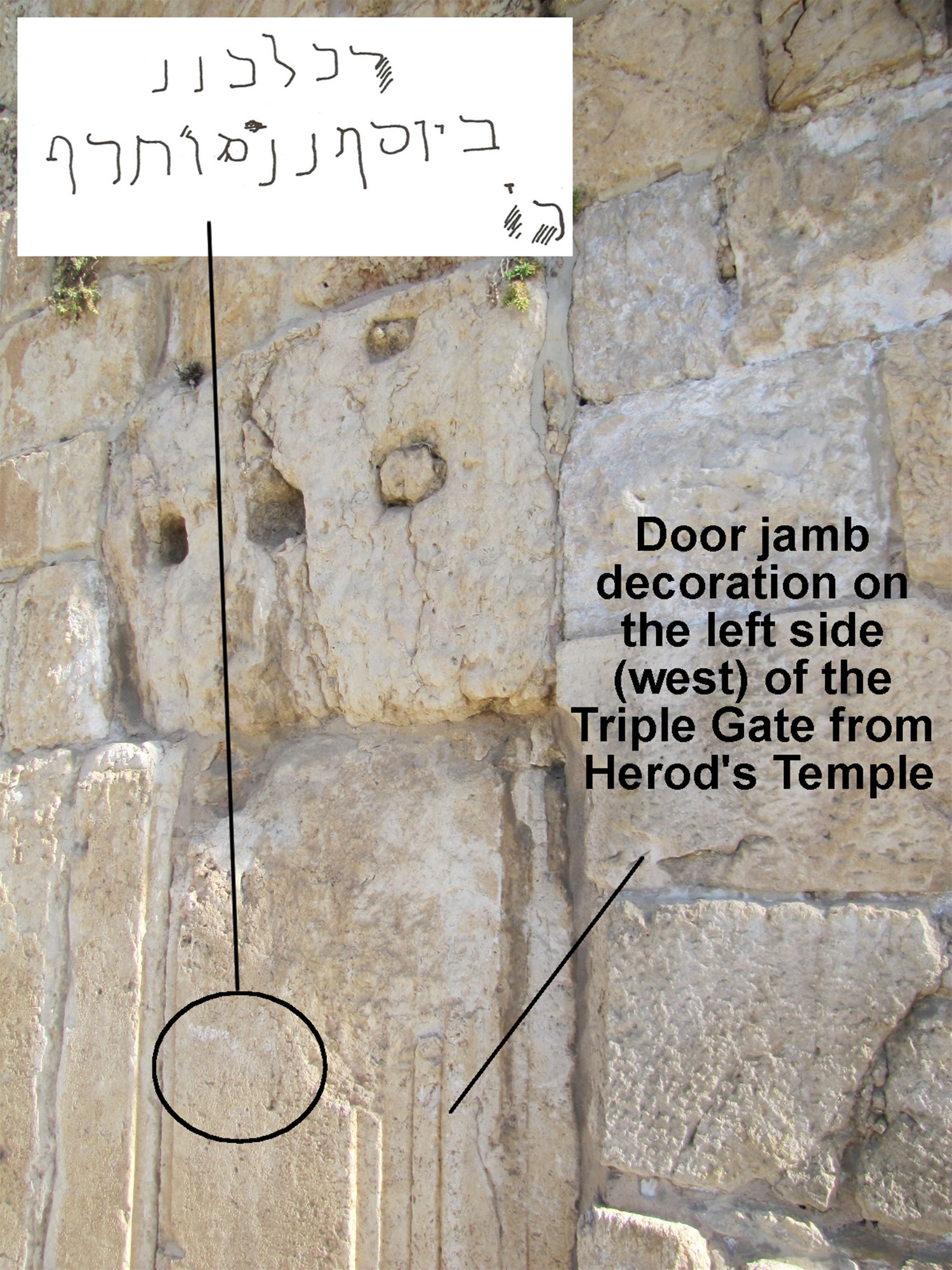
There is a Hebrew inscription on the carved molding of the jamb of the Triple Gate. The inscription, possibly a memorial, consists of the names of two Jews who had died. The inscription is dated at around 750 AD when the Muslim Abassid dynasty ruled, and Jews could only worship at the gates of the Temple Mount.
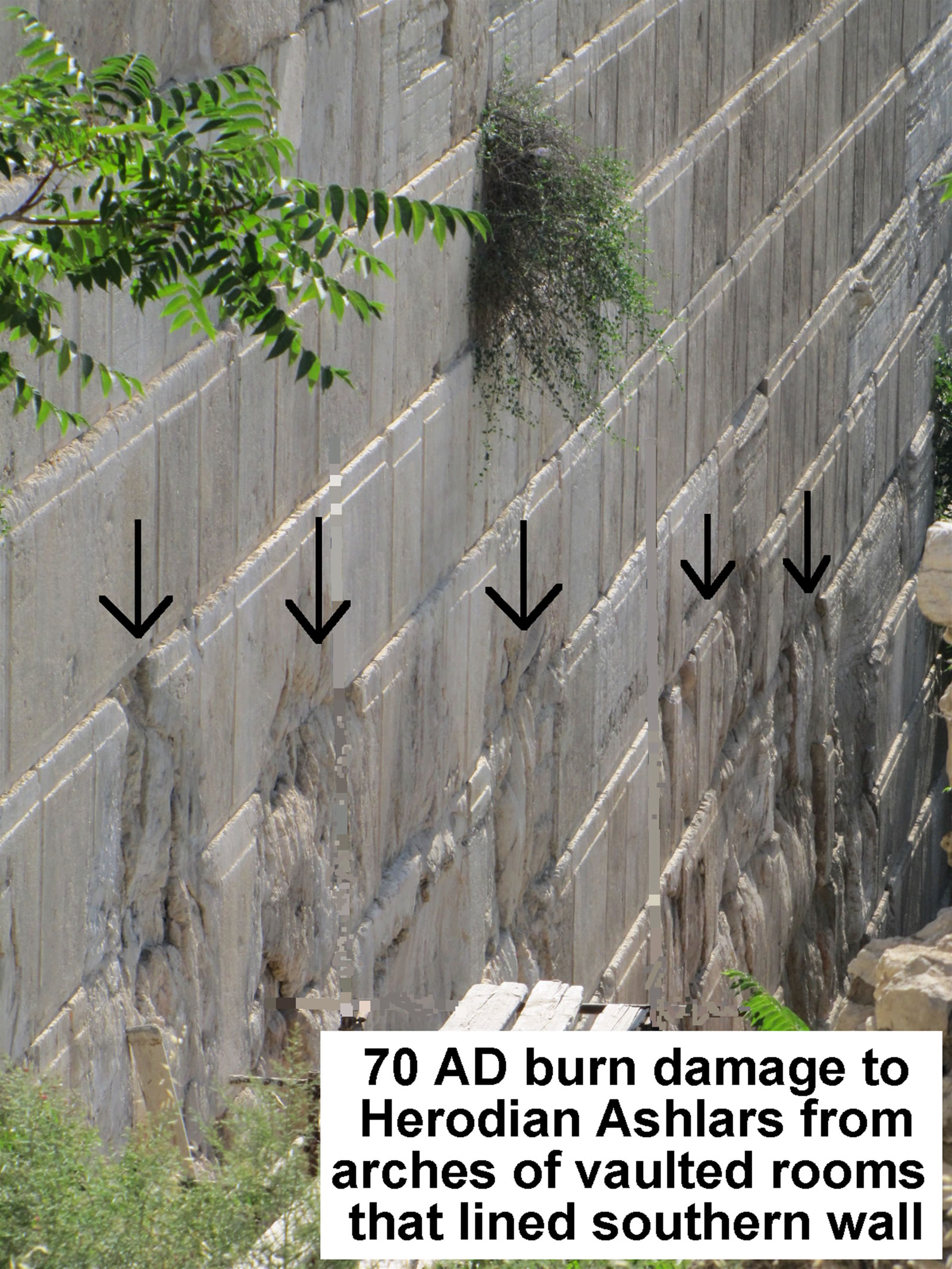
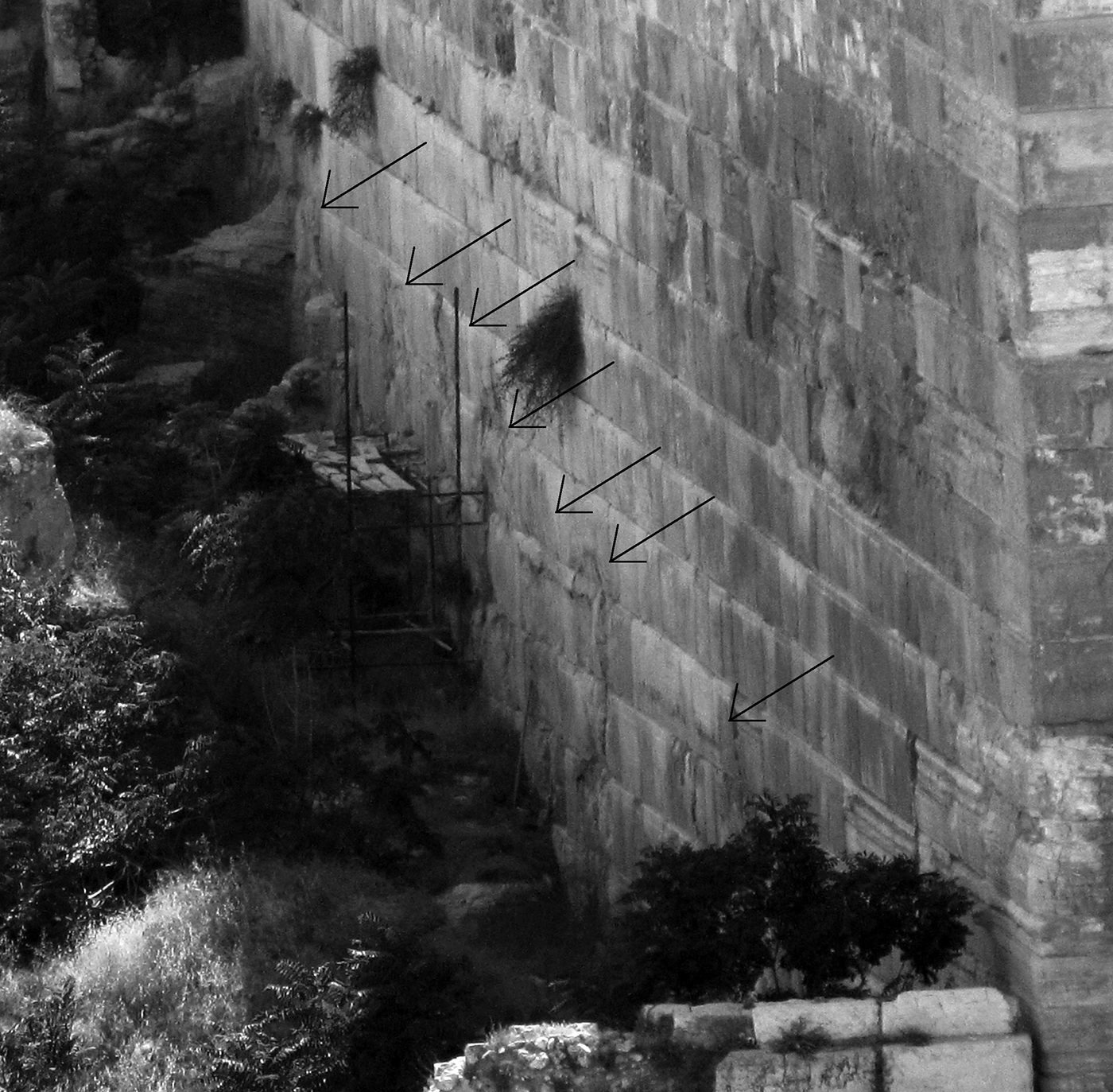
The intense heat of the Roman destruction created burnt impressions on the southern wall of the Temple Mount, outlining the arches of the vaulted rooms that supported the paved street as it descended. Shops were located in these vaulted rooms under the street.